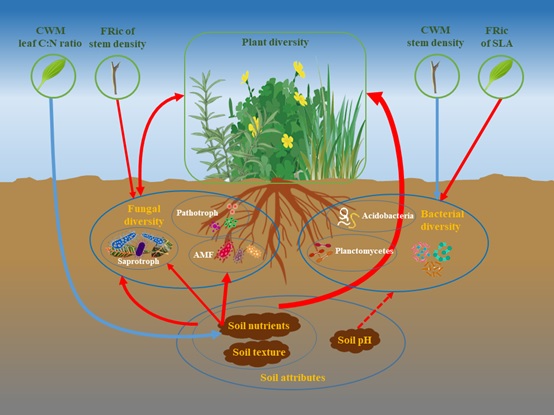A research team led by Prof. HUANG Zhenying from the Institute of Botany, the Chinese Academy of Sciences along with other collaborators have unveiled the linkage between plant diversity and soil microbial diversity of different taxa in the grasslands.
Their study entitled by "Plant diversity has stronger linkage with soil fungal diversity than with bacterial diversity across grasslands of northern" has been published in Global Ecology and Biogeography.
The interactions between plants and soil microbes play crucial roles in modulating the function and stability of terrestrial ecosystems. However, the linkages between plant and soil microbial diversity for different taxa have remained been elusive.
Researchers investigated on the relationship between above- and below-ground biodiversity along a large transect gradient in the grasslands of northern China, covering 1, 700 km geographical distance.
By means of field survey for consecutive 2-year data, they characterized plant functional diversity of leaf and stem traits, and the diversity of soil bacteria and fungi, as well as the diversity of pathotrophic fungi, saprotrophic fungi and arbuscular mycorrhizal fungi (AMF) by high-throughput sequencing.
They found that plant diversity (including species diversity and functional diversity) had a strong coupling with soil fungal diversity, but it was decoupled from bacterial diversity. Plant and fungal diversity were driven by soil nutrients and texture, while bacterial diversity was mainly affected by soil pH.
In addition, researchers identified that pathotrophic fungi, saprotrophic fungi and AMF formed multidimensional interactions with plants, further regulating plant diversity. “These results highlight the importance of AMF and saprotrophic fungi in interactions with plants,” said the co-correspondence author Dr. LIU Guofang.
This study reveals that how soil microorganisms regulate plant diversity, and emphasizes the vital role of soil fungi in shaping the structure and function of plant communities. The loss of soil fungal biodiversity due to the impact of climate change and anthropogenic activities could decrease aboveground biodiversity and ecosystem productivity while increasing ecosystem instability.
“Our founding suggest that integrating soil fungi into the framework of plant diversity conservation will therefore contribute to better informed choices for biodiversity restoration in degraded grassland ecosystems,” said Dr. LIU.

The summarizing model depicts the direct and indirect relationships between plant attributes (plant diversity and plant traits) and soil bacterial and fungal diversity. (Image from IBCAS)
Article Link: https://doi.org/10.1111/geb.13462
Contact:
HUANG Zhenying,the Institute of Botany, the Chinese Academy of Sciences
Email: zhenying@ibcas.ac.cn
A research team led by Prof. HUANG Zhenying from the Institute of Botany, the Chinese Academy of Sciences along with other collaborators have unveiled the linkage between plant diversity and soil microbial diversity of different taxa in the grasslands.
Their study entitled by "Plant diversity has stronger linkage with soil fungal diversity than with bacterial diversity across grasslands of northern" has been published in Global Ecology and Biogeography.
The interactions between plants and soil microbes play crucial roles in modulating the function and stability of terrestrial ecosystems. However, the linkages between plant and soil microbial diversity for different taxa have remained been elusive.
Researchers investigated on the relationship between above- and below-ground biodiversity along a large transect gradient in the grasslands of northern China, covering 1, 700 km geographical distance.
By means of field survey for consecutive 2-year data, they characterized plant functional diversity of leaf and stem traits, and the diversity of soil bacteria and fungi, as well as the diversity of pathotrophic fungi, saprotrophic fungi and arbuscular mycorrhizal fungi (AMF) by high-throughput sequencing.
They found that plant diversity (including species diversity and functional diversity) had a strong coupling with soil fungal diversity, but it was decoupled from bacterial diversity. Plant and fungal diversity were driven by soil nutrients and texture, while bacterial diversity was mainly affected by soil pH.
In addition, researchers identified that pathotrophic fungi, saprotrophic fungi and AMF formed multidimensional interactions with plants, further regulating plant diversity. “These results highlight the importance of AMF and saprotrophic fungi in interactions with plants,” said the co-correspondence author Dr. LIU Guofang.
This study reveals that how soil microorganisms regulate plant diversity, and emphasizes the vital role of soil fungi in shaping the structure and function of plant communities. The loss of soil fungal biodiversity due to the impact of climate change and anthropogenic activities could decrease aboveground biodiversity and ecosystem productivity while increasing ecosystem instability.
“Our founding suggest that integrating soil fungi into the framework of plant diversity conservation will therefore contribute to better informed choices for biodiversity restoration in degraded grassland ecosystems,” said Dr. LIU.

The summarizing model depicts the direct and indirect relationships between plant attributes (plant diversity and plant traits) and soil bacterial and fungal diversity. (Image from IBCAS)
Article Link: https://doi.org/10.1111/geb.13462
Contact:
HUANG Zhenying,the Institute of Botany, the Chinese Academy of Sciences
Email: zhenying@ibcas.ac.cn
